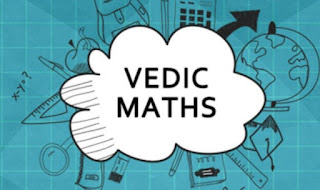VEDIC MATHS-11
VEDIC MATHS
By OMKAR TENDOLKAR
Hello friends,
This is our eleventh blog from the series of "Vedic maths" blogs. Here in this blog we will learn about "multiplications of numbers whose last digits add to 10 and the remaining digits should be the same".
The technique of squaring number ending with 5 is a very popular technique. Some education board have included it in their curriculum. In Vedic mathematics, there is an extension to principle which is not know to many people. This formula of Vedic Mathematics tells us that the above rule is applicable not only to the squaring of numbers ending in 5 but also to the multiplication of numbers whose last digits add to 10 and remaining digits are the same.
Reference:
We had already learn about "squaring of numbers ending with '5'" In our previous blog. If you have missed my last blog then please visit "VEDIC MATHS-10".
Special multiplications:
Here in this blog we will learn about "multiplications of numbers whose last digits add to 10 and the remaining digits should be the same".
Necessary condition:
- last Digits should add to 10
- Remaining digits should be the same.
Example:
1) Multiply the number 66 by 64
66
× 64
---------
In the above examples, it can be observed that the last digits in each case add up to 10 and the remaining digits are the same. Let's us take the first examples...
- Here the last digits are 6 and 4 which add up to 10. Secondly, the remaining digits are the same, viz. '6' and '6'.
- Thus, we can find the square of this number by the same principle which we used in squaring numbers ending with a 5.
- First, multiply the number 6 by the number that follows it. After 6 comes 7. Thus, (6×7) is 42.
- Next, we multiply the right handed most digits (6×4) and write the answer as 24.
- Our answer is 4224.
Answer:
66 × 64 = 4224.
2) Multiply the number 107 by 103
107
× 103
---------
In the second example, we have to multiply 107 by 103. In this case the last digits 7 and 3 add to 10 and remaining digits are same. We will obtain the product using same procedure.
- First, we will multiply the number 10 by the number that follows it, 11. Write the answer as 110.
- Next, we multiply the right handed most digits (7×3) and write the answer as 21.
- Our answer is 11021.
Answer:
107 × 103 = 11021.
3) Multiply the number 91 by 99
91
× 99
---------
- We Multiply 9 by the number that follow it, 10, and write the answer as 90.
- We Multiply the number (1×9) and write the answer as 09. The final answer is 9009.
(Note: The right part should always be filled-in with a two digit number. Thus, we have to convert the number 9 to 09.)
Answer:
91 × 99 = 9009.
This formula of Vedic Maths works for any such numbers whose last digits add up to ten and remaining digits are the same. The same formula works while squaring numbers ending with 5 because when you square two numbers ending with 5, then the right hand most digits add to 10 (5 plus 5) and the remaining digits are the same ( since we are squaring them).
Let us look at few other examples where right-hand most digits add to 10 and the remaining digits are the same.
More examples:
- 72 × 78=5616
- 84 × 86=7224
- 23 × 27=0621
- 89 × 81=7209
- 45 × 45=2025
The simplicity of this method can be vouched from examples given above.
You may try following example:
1. 67 × 63
2. 52 × 58
3. 41 × 49
You may answer this in comment box. You may ask your any query or doubt in comment box. I will try to resolve as early as possible.
In next blog we will discuss about "Squaring of numbers between 50 and 60".
Are you excited for this?...
Then, please wait for it.
I will post my new blog in next week.
We will meet very soon through our next blog. Till that stay connected, stay healthy and stay safe.
Thanks
for giving your valuable time.
Good day😊.


Wow I like this but please update/ publish more work at this website
ReplyDeleteyes sure
Delete